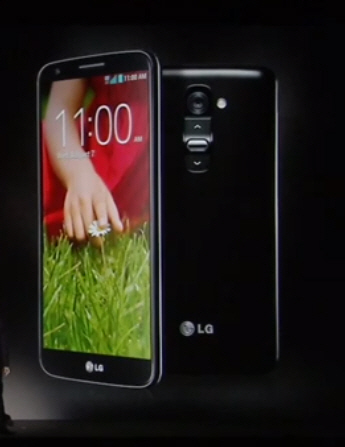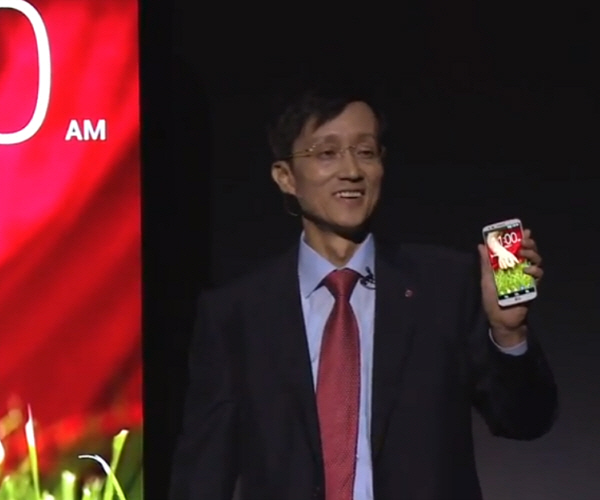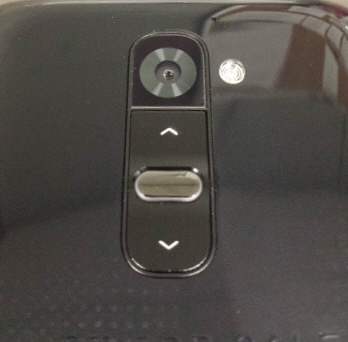LG Electronics just wrapped up its New York City, Lincoln Center (more specifically, at the Frederick P. Rose Hall, Home of Jazz at Lincoln Center) launch event for its new flagship smartphone, the LG G2, the first in its new line of G series devices with some "different" smartphone approaches (LG's first G series device was the Optimus G). The event itself was understated in spite of the glamorous setting but was quite effective, with the company communicating a really strong sense of having spent a great deal of time - thousands of hours - seeking to understand what we "as humans" need and want our mobile devices to do.
Before we get to the subtleties, first things first - let's just get the core specifications out of the way:
- Processor: 2.26GHz Qualcomm Snapdragon 800 featuring quad Krait CPU
- Display: Near edge-to-edge, 5.2-inch Full HD IPS (1080 x 1920 pixels, 423 ppi)
- Controls: Back of device buttons only - no other buttons either on sides or front of the G2
- Memory: 32GB/16GB
- RAM: 2GB LPDDR3 800MHz
- Camera: Rear 13 Megapixel with enhanced low light and OIS/Front 2.1 Megapixel
- Battery: 3,000mAh, in a reduced size
- Operating System: Android Jelly Bean 4.2.2
- Size: 138.5 x 70.9 x 8.9mm (.3 inches thick)
- Colors: Black, White

Expect the LG G2 to be rolled out across 130 wireless carriers in the next eight weeks. The rollout will begin in South Korea, followed by North America, Europe and then other key markets.
Dr. Jong-seok Park, president and CEO of the LG Electronics Mobile Communications Company, (shown below introducing the G2) began the event by delivering a short but very interesting and effective pre-amble that focused on LG's definition of innovation, or as he put it, "Technology that truly resonates with consumers, technology and innovation with empathy. Innovation simply for the sake of innovation is old school.” We especially like that "old school" dig. Those lines certainly strike us as a dig at a certain South Korean competitor, and indeed the event and the new G2 itself are clearly counterpoints to a certain vaudeville-level event that took place earlier this year.

There are a number of hardware features that now define the state of the art for LG. First there is the use of Qualcomm's super-fast Snapdragon 800 processor, the first official use of new processor in a major global mobile device. There is a new battery design that increases battery life but also manages to reduce size - an important feature related to and necessary for the G2's new control buttons location. The near edge-to-edge design of the display, meanwhile, delivers a 5.2-inch screen within the confines of a more or less standard 2.7 inch wide device.
Step to the Back of the Bus Please
Those 2.7 inches are nevertheless still on the wide side, and this is where LG looked to especially apply some extensive design efforts. The challenge was to keep the smartphone exceedingly thin (in the case of the G2, it is just less than 9 mm thin) and to find a way to ensure that users would still be able to have "full one hand control" of the control buttons regardless of the width of the device. This challenge leads us to the most unique feature of the G2 - all of the buttons and side keys have been moved to the back of the device - where LG's extensive consumer research has found most users tend to place their index and other fingers a significant amount of the time. The G2 has absolutely no side or front keys, contributing to its sense of sleekness.
LG's researchers found that moving the buttons to the back resulted in fewer dropped phones, especially when adjusting the volume while talking. Manipulating the side keys on the Galaxy S4 (and S III for that matter) has always annoyed us so we understand the issues LG is looking to solve here. We won't of course get any real sense of whether or not moving the controls to the back of the device really make an impactful difference until we are able to take the device for a full test run, but from a pure design perspective it strikes us that this should in fact work quite well.
A "long press" on the rear-mounted volume keys allows users to launch LG's QuickMemo and the G2's camera. LG has also added several display screen capabilities - for example, it's new "KnockON" capability lets a user power on the G2 simply by tapping twice on the display.
Excellent Display and Stepped Up Audio Quality
The G2's full HD display is bright and energetic looking. It has a "happy birthday celebration” kind of look but ultimately what we mean is that the display is more than adequate to compete against the rest of the high-end smartphone field, but there is nothing here that takes us to any new level of extraordinary. It is ordinary in a high-end way - and this means that the display quality isn't going to be a factor in consumers choosing the G2 over a competitor.
LG nevertheless claims it has a display differentiator in hand. The G2 makes use of Graphic RAM (GRAM) technology. LG claims that GRAM reduces a display’s energy requirements by as much as 26 percent on a still frame. LG also claims that it increases overall usage time on the device by about 10 percent. In combination with the newly designed 3,000mAh battery we noted earlier, LG claims the G2 will run over 24 hours under normal conditions. We'll leave it to the geek testers who monitor this sort of thing to report back when they can test the battery under their usual arrays of stress tests. For now it remains LG hearsay, but we suspect there will be some truth to be found in LG's power claims.
One thing almost no smartphone vendor ever really talks about is sound quality. Typically smartphones are able to manage CD-quality sound, and for most people this is well beyond good enough. For those of us who have built high-end sound rooms over the years, the sound quality is always a joke but the convenience always makes up for it. We will say that a good headset, such as the newly released Plantronics BackBeat GO 2 wireless headset, does make a significant quality difference.
Given this set of scenarios it was quite interesting to hear that the engineers at LG decided to take audio quality up a significant notch. LG claims that the G2 is the first smartphone on the market today to deliver 24 bit/192kHz. This is a huge step up from typical CD quality sound. We're looking forward to giving the G2 a run with the Plantronics headset. Of course the downside to this is that poorly recorded music (which, sad to say, is the norm) will sound much worse than it usually does. Ultimately it is always about the quality of the recording that makes the difference. But we're excited to test LG's claimed sound improvements and look forward to it.
Camera Updates
LG didn't spend much time on the G2's camera but it is in keeping with the now-standard 13 megapixel resolution of the Galaxy S4. LG did look to put itself in the land Nokia's Lumia 1020, sort of, by focusing on its low light capability and in particular its new optical image stabilizer (OIS) capability.
LG claims that the latter isn't just some buzz words it is throwing around, and claims that its OIS delivers a significant qualitative improvement to photos. It claims that clearer, brighter and sharper images even when in motion or shooting in dim environments will become the norm rather than the exception. LG also claims that most current smartphone cameras with OIS only deliver resolution in the 4MP to 8MP range whereas the G2 is unique in delivering full 13 megapixel OIS resolution. LG also took a direct swipe at Nokia by noting that it delivers its camera within the G2's slim design "without a protruding lens and camera section."
As with battery life and other standard features, we'll leave it to the usual testers to offer up full comparative details. For us the camera - which we'll note is, like Apple's iPhone 5 camera, protected by a sapphire lens cover (a very nice touch) - is suitable but we don't believe it will be anywhere near as good as the Lumia 1020.
LG's Brand of User Experiences
As do its competitors, LG overlays the underlying Android (in the case Jelly Bean 4.2.2 - same as the Moto X that was introduced last Friday, so it isn't the absolute latest 4.3) UI with its own features. These include the following:
- Answer Me: Automatically answers the call after lowering the ringtone when the phone is raised to one’s ear
- Plug & Pop: Recommends options or related features to choose from when the earphone or USB cable is detected
- Text Link: Allows information embedded in text messages to be selected and easily saved in a memo or calendar and searched on a map or the Internet
- QuickRemote: Not only can LG G2 be used to remotely control popular home entertainment devices, it can also learn from conventional remotes and be customized to operate multiple devices with flexible layouts and keys
- Slide Aside: Enables easier multitasking by simply “sliding” open apps off to the side using a three-finger swipe
- Guest Mode: Protects owner’s privacy by displaying only pre-selected apps when guests access the phone with a secondary unlock pattern
These strike us as fairly simple and useful features, but it will need to be a real test run that determines this. Nothing here strikes as gimmicky however, and that is important overall in terms of how the user and the device interact.
Does the Design Cut It?
Moving the controls to the back of the device is a bold step. There is a risk that in spite of LG's extensive research, consumers won't end up liking the shift or taking to it in significant numbers, but at least LG is giving something truly new and possibly quite useful a shot. Feature-wise, it lacks wireless charging and NFC support, but it certainly stands up to the HTC One, the Galaxy S4, Nokia's Lumia 920 and 928 (though not the Lumia 1020), and the new Moto X (although the Moto X has its own several unique features we find quite useful) overall.
But does the G2 stand up to the Apple standard of fit and finish? Is it…jewel-like? No, it doesn't come close, even though it does deliver on the sapphire lens cover. The design overall is much more Galaxy S4 than anything else. It's thin, yes, but ultimately a bit drab in terms of the overall case and overall look, even with its near edge to edge display. It certainly doesn't touch the HTC One on the pure design front either. But these things may not matter to a majority of consumers. And perhaps moving the control keys to the back of the device will prove an over-the-top win.

So once again we have a brand new flagship mobile device that sets some new innovation bars, yet once again we find ourselves still waiting for Godot. Or Apple.
We ourselves have set some significant expectations for what Apple will bring us in short order. Until then, the LG G2, Moto X, HTC One, Nokia's Lumia 1020 and Samsung's Galaxy S4 will have to simply wait it out on the sidelines.
It is certainly quite possible that Apple will drop the ball and allow one of these other players to really take over. And there is also the Brooklyn Bridge that still remains for sale.
Edited by
Rachel Ramsey
 QUICK LINKS
QUICK LINKS